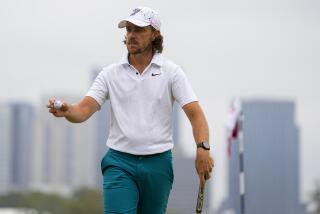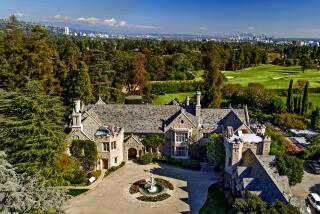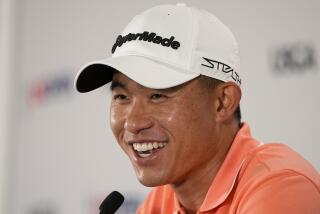OTHER MAJOR CHAMPIONSHIPS PLAYED AT WINGED FOOT
- Share via
1929 U.S. OPEN
Al Espinosa learned something about crash landing in a major tournament in 1928. That year, he advanced to the final of the PGA Championship, which was then match play. The next day, Espinosa was trounced by Leo Diegel, 6 and 5. During the fourth round of 1929 U.S. Open at Winged Foot, Espinosa made up four shots on Bobby Jones, and Jones had to sink a curling, 12-foot par putt on No. 18 to force a 36-hole playoff the next day. Espinosa lost by an astonishing 23 strokes, 141-164, as Jones won the third of his four Open championships.
Jones returned to Winged Foot in 1954, where there was an exhibition and a small celebration of his triumph. Tommy Armour, Gene Sarazen and Johnny Farrell were given chances to make the same putt Jones had dropped, under far less pressure, of course. All missed. When Jones was given the opportunity to try the putt again, he reportedly said, “No, thanks. I already made it.”
1959 U.S. OPEN
Billy Casper had won six times before 1959 and had established himself as a consistent player with an extraordinary short game. But even though he had finished second in the PGA Championship the year before, he wasn’t considered a front-runner in the majors. That changed in the 1959 Open on Winged Foot greens slowed by frequent thunderstorms. Casper needed only 114 putts over 72 holes and defeated Bob Rosburg by a shot, at two-over 282. Players in the ’74 Open over the same course would use almost that many putts in three rounds. There was a third-place tie between Mike Souchak, a former assistant pro at Winged Foot, and the head pro at the time, Claude Harmon. He was the father of Butch Harmon, who grew up playing the course and is now coach of Tiger Woods. Some say that course knowledge will help Woods this week; others say the more you know about Winged Foot’s many trouble spots, the more you worry about ending up there.
1974 U.S. OPEN
Many players, accustomed to playing layouts where birdies are as common as bunkers, whined that the setup for the ’74 Open was unfair. Everyone agreed that by Sunday, the only one left standing would probably be the course. It certainly withstood anything the players could throw at it. No one broke par 70 on the first day, and only eight rounds after that were in the 60s. There were 103 scores in the 80s. The day before the tournament began, Bobby Nichols, who had won a PGA Championship and 10 other events, said, “The U.S. Open course? It looks like 18 bogeys.” He was right on for two players, who finished their first round at 18-over 88, and not too far off for himself. Nichols played four rounds in 25 over. Hale Irwin withstood Winged Foot’s claws better than anyone; he won at seven-over 287, never shooting a round under par. He shot a final-round 73 . . . and came from behind to win.
1984 U.S. OPEN
Remember those colored golf balls that were all the rage among high handicappers a dozen years or so ago? Well, Hale Irwin used a lime-green ball at the ’84 Open and held the lead in spite of it through the first three rounds. But tradition prevailed on Sunday when Irwin ballooned to a 79 in the fourth round. The tournament evolved into a two-man competition between Fuzzy Zoeller and Greg Norman. Zoeller moved four shots ahead of Norman with four consecutive birdies on the front nine before his game leveled off. Norman made par-saving putts on 16 and 17, and when he dropped a 40-footer on 18, Zoeller, playing behind Norman and thinking it was a potentially winning birdie putt, waved a white towel in mock surrender from the fairway. But the putt had been only for par, Zoeller also got his par on 18 to tie and then trounced Norman in the 18-hole playoff the next day, 67-75. On the 18th hole of the playoff, Norman waved his own white towel.
More to Read
Go beyond the scoreboard
Get the latest on L.A.'s teams in the daily Sports Report newsletter.
You may occasionally receive promotional content from the Los Angeles Times.










